Down to Earth
Deteriorating walls hold the story of Fort Selden. Can we save them? Should we?
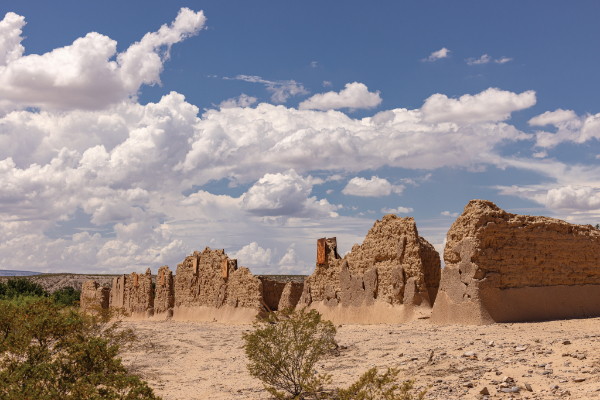 The south side of the Fort Selden barracks. The base of these walls
had preservation work completed in 2021 which has helped strengthen
the overall stability of the walls. Photograph by Tira Howard.
The south side of the Fort Selden barracks. The base of these walls
had preservation work completed in 2021 which has helped strengthen
the overall stability of the walls. Photograph by Tira Howard.
By Kate Nelson
So much that could have gone wrong in 1865 at Fort Selden Military Reserve somehow didn’t. Soldiers outfitted with inferior tools and a lackadaisical spirit, occasionally enlivened by one officer’s proffer of whiskey, nevertheless managed to stack adobe bricks into walls and hoist vigas to the ceilings. Once constructed, the fort withstood the vagaries of life on the southern frontier of New Mexico Territory. Soldiers crowded into barracks on the south end of the parade ground while officers and their families enjoyed more spacious homes on the north.
Up to 200 people occupied the fort, with varying levels of crabbiness. When not patrolling the hinterlands by horseback to ensure the safety of miners and settlers, the soldiers battled boredom, often smuggling alcohol onto the grounds and erupting into fistfights. Several companies of Buffalo Soldiers—African American troops—were stationed at Fort Selden. According to Alexandra McKinney, instructional coordinator supervisor at Fort Selden, these units were segregated from their Anglo counterparts and the Buffalo Soldiers were regularly subjected to racial discrimination.
Some soldiers used their on-duty sorties to search for personal mining claims. Others found pleasure in sex workers and gambling beyond the fort’s boundaries. A few deserted.
The fort was temporarily abandoned in 1878. By the time it was reactivated in 1880, most of the buildings required significant reconstruction to make them habitable. Some were left in such disrepair they had to be demolished entirely.
The fort was commanded by Arthur MacArthur, whose son Douglas grew up to become a legendary World War II general in 1887, the fort began a four-year slouch toward dissolution, as did other military outposts in the territory. Between 1889 and 1896, forts Cummings, Marcy, Union, Selden, Craig, Stanton, and Bayard closed. An 1896 inventory of Fort Selden said all that remained were “parts of walls and piles of dried mud.”
After fits of construction, drunken brawls, warfare with Apache people, and an on-and-off record of occupation, the thing that truly went wrong with Fort Selden was this: the army marched away.
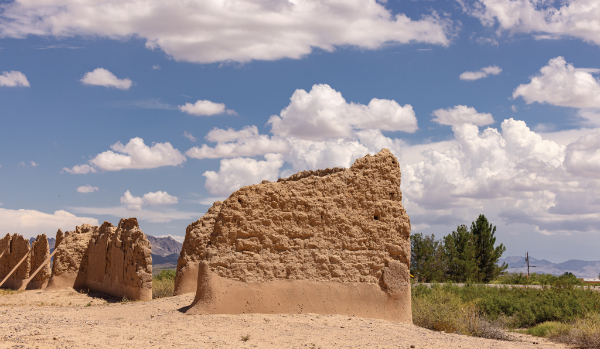
“When it became a state monument in 1973,” says former Southern Region Manager for New Mexico Historic Sites Rhonda Dass, “eighty-five percent of the structures were gone. The military took every scrap of wood from it. Most of the foundations that were there are still intact, but I’m sure if we looked around the community at other older structures, there are rocks and things embedded in them from the fort.”
An adobe wall without a roof will begin to wither with every drop of rain. Adobe bricks at the base of the wall slurp up moisture through a capillary action that leaves salt deposits within them, breaking down their solidity. For nearly a century, until the state took possession, no savior showed up with mud plaster to smear on the walls, and no visionary sounded an alarm persuasive enough to ensure the fort’s preservation.
Today, telling a coherent story from what’s left on the 28-acre site can challenge the best interpretive ranger and the most engaged friends group—both of which Fort Selden Historic Site has. The lumpy remnants of walls at Fort Selden have already endured decades of cash-strapped neglect from the state and now, even with infusions of money, are challenged by surprisingly spiteful rains and piercing sandstorms, as well as dramatically increasing construction costs and an infestation of subterranean termites. Though mute, the eroded structures pose questions all too familiar to those who treasure the preservation of our past: “How little is too little, and how much is too much?” Dass says. “How much can we intercede? Can we rebuild what’s already there? What have we learned, what works, and what doesn’t work? There’s a total spectrum of what we can do. And it all depends on funding.”
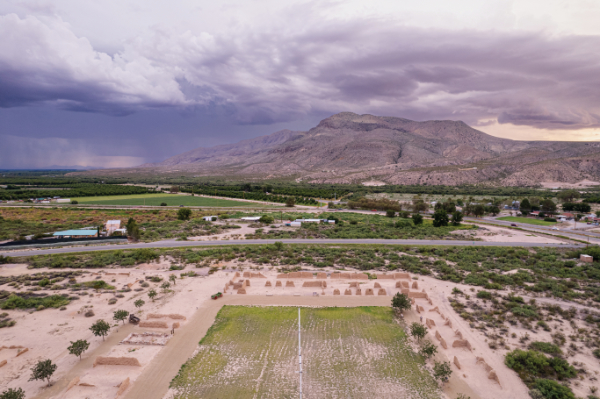
Pat Taylor, an adobe preservationist based in Mesilla, near Fort Selden, has overseen various attempts to stabilize the fort’s walls. He brings a globalist’s knowledge of how adobe works and says any such building’s long-term success depends on three things: “Good dirt, good application, and cyclical maintenance.”
Fort Selden, which sits in today’s Radium Springs about sixteen miles northwest of Las Cruces, did well enough on the first two tenets. Even barring adequate maintenance, it held up reasonably well after its abandonment. His parents, Mary and J. Paul Taylor, used to bring their large family to the site for lazy picnics conjoined with childhood treasure hunts for military buttons and other artifacts.
The experiences surely helped inspire Pat’s fascination with old adobe buildings, as it did the archaeology and museums career of one of his brothers, Michael Romero Taylor, who later served as deputy director of New Mexico State Monuments, a precursor to the Historic Sites Division.
One of Michael’s first state gigs was “doing grunt labor” for an archaeological exhibition at Fort Selden. “Back then,” he says, “our research design was along the lines of ‘Go find the goodies.’ We excavated the magazine where the ammunition had been stored and the latrines for the hospital, the officers, and the enlisted men. In the soldiers’ latrines, we found lots of liquor bottles, one opium pipe, and bullets. It was against military regulations to carry live ammo, but a lot of the men would shove bullets into their pockets during target practice. Later, they’d realize, ‘Oh, I screwed up,’ and throw them down the latrine.”
We’re sharing memories inside the welcome cool of the historic site’s visitor center on a blazing summer day. The center contains a small museum created in the 1970s that holds some of Michael’s finds, as well as those he and his family collected when the property was still in private hands. His favorite is a beat-up pair of children’s shoes excavated in the 1970s that he loves telling people were General Douglas MacArthur’s. “That’s speculation,” he says with a wink.
Their father’s death in February 2023 has plunged the brothers and their siblings into a process of dividing what they want from his longtime Mesilla home before it completes its transformation into the state’s Taylor-Mesilla Historic Site, tasks that have added a golden burnish to their Fort Selden memories.
“The walls were still pretty high,” Michael says. “There was enough to be able to experience the form and outline of the fort. You could tell where the doors and windows were. You could see how cool it was.”
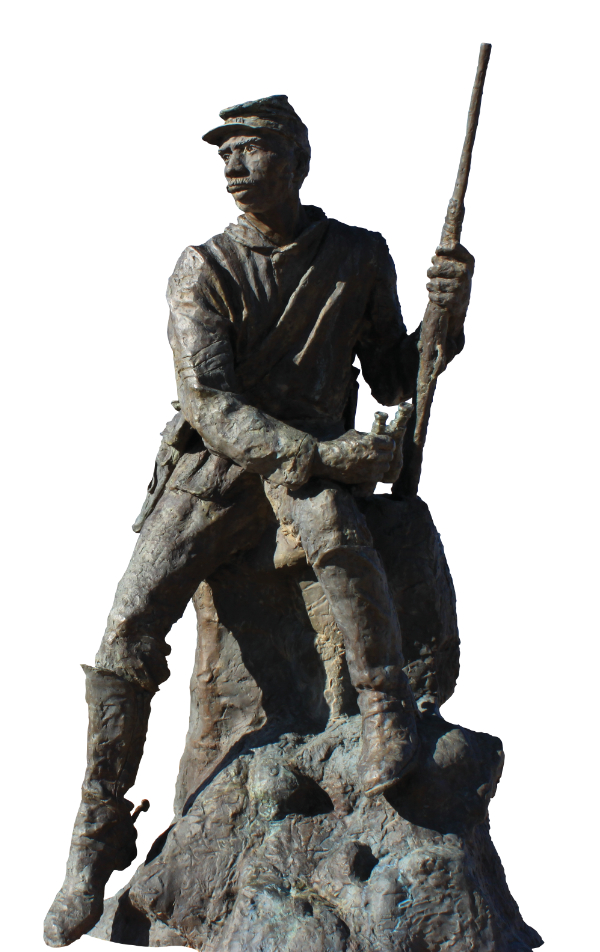
“It was a maze,” Pat adds. “There were a lot of room blocks.”
When we finally steel ourselves for the heat, I try to imagine them as boys scampering through a shimmering mirage of buildings. It isn’t easy.
Few of the existing walls reach much higher than our heads.
Once two feet thick, they’ve eroded in patterns best described as linear triangles, with bases that, in some cases, measure barely a foot wide. The undulation of their eroded tops mimics the more distant silhouette of the Robledo Mountains.
“Adobe melts,” Pat says. “That’s a given. Once you lose a roof, it happens quickly.”
Over the years, the state’s attempts to slow the erosion have included capping the walls with protective coverings and shoring up the bases. Paradoxically, every at-tempt to help invites harm. Original adobes below a cap or above an amended base can erode at an even higher rate. Compensating for the erosion can require redoing the caps and bases every few years, incurring expenses that gobble up the opportunity to exact other repairs.
When he worked for State Monuments, Michael joined forces with other like-minded preservationists at the Getty Conservation Institute to build test walls in an open area east of the visitor center. The intent was to try out a variety of plasters, mud, and chemical additives that could withstand desert sun, rain, and wind.
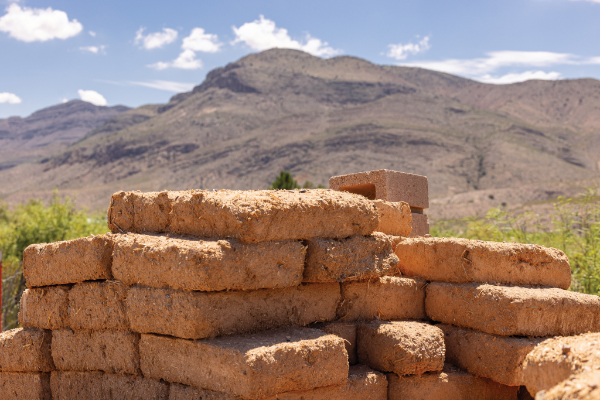
“We had good crews working for the historic sites, but we always wanted to know if a magical elixir could be applied to the walls to fix them. In the end, only one acrylic polymer worked,” he says of Rhoplex E330. “But we were purists at the time, and a lot of people didn’t like the idea of adding something to adobe.”
The effort also resulted in “Adobe 90,” an earthen-architecture conference in Las Cruces in 1990 that drew 300 attendees from all around the world, many of whom developed an ongoing interest in Fort Selden.
Years ago, Michael oversaw a bracing project that failed to perceive that the walls had adjusted to swaying a bit with the wind. One of the walls collapsed. Future braces—metal plates screwed high into the walls and held with diagonal posts—took the wind’s power into account and have held up well.
In 2021, Pat found a local adobe maker to help Avanyu General Contracting, a woman-owned San Ildefonso Pueblo–based team, build up the foundations of the old soldiers’ barracks. “They went down to a certain depth, repaired and replaced the adobes, then mudded it over,” he says, as he points out the long line of work, which included adding manure and lime to the plaster coating—both of them traditional materials. “It’s holding. But that’s a 1970s, 1980s layer above it, and it’s delaminating now.”
Delamination, the peeling away of surface plaster or even the adobe bricks themselves, afflicts buildings throughout the site. While wandering paths interspersed by mesquite scrub, prickly pear cactus, and creosote bushes, a visitor can spy walls with surfaces appearing to have slumped or actively sloughing off.
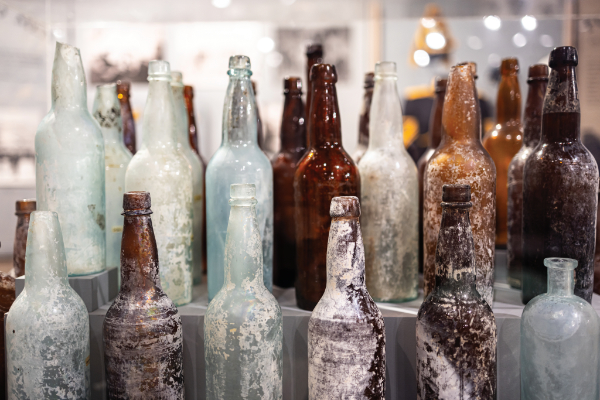
We stop at the hump of a berm surrounding the old corral. Pat notes there should be six inches of fill dirt on top of it at all times. Rain has washed it all away.
Over the past decade, more state money has flowed to improve the site, including roughly $50,000 to replaster the officers’ quarters about six years ago. One rainstorm erased it.
“That happens more and more often,” says Dass. Among the brutalities climate change has wrought upon southern New Mexico are frequent windstorms and damaging rains. “We had more rain last year than we’ve had in a long time,” she says.
“And we ended up with subterranean termites coming up through the adobe. No one could have predicted that. Everything had to stop while we killed off the termites.”
Meanwhile, the pandemic drove construction prices higher and higher.
The Taylor brothers acknowledge that family memories impact how much importance they place on Fort Selden. And they realize that other historic sites and the state’s museums likewise require costly care. Still, they can’t help but feel a touch of sorrow for the fort’s appearance and how it dampens the visitor experience. Michael wonders whether alternatives to standard historic preservation practices could be considered for at least one corner of the site. Maybe, he says, they could erect a protective structure over one portion of the ruins and recreate one of the buildings on another corner —“even if we don’t know exactly what it looked like.” Emerging museum technology might be able to help, too, he says. Perhaps some kind of digital projection could give visitors a clearer idea of how people once moved through a building that long ago crumbled.
He knows each idea invites criticism from some pres-ervationists and inhales breathtaking amounts of money. But, he says, “We’ll eventually lose even what we have now.”
“The fort is at a real pivotal place,” Pat adds. “And it’s been there for a while. There needs to be some thinking about what the end game is. The interpretation and keeping people’s interest are driving forces. You can’t just have a continually eroding wall.”
In the 1990s, while an undergraduate at New Mexico State University, Patrick Moore drove from Las Cruces to what was then called Fort Selden State Monument. Walking through the museum, he thought, Wow, these exhibits are really out of date. When he became director of the Historic Sites Division in 2016, he says, “It was pretty much the same exhibit.” Beyond the issues with preserving adobe structures, he faced a host of problems that had to be fixed before the exhibits could change. Among them were an outmoded heating-and-cooling system, inadequate visitor parking, and the installation of accessibility-compliant paths. This past summer, the museum’s aging floor was replaced.
He credits state senator Jeff Steinborn, whose district includes Radium Springs, for being a hero to the site, which relies on state money for all capital improvements including adobe preservation. Before Steinborn’s aid, Moore says, the fort had a tough time making a case for itself. “It’s the smallest and least visited of all the historic sites, with only a few thousand people coming through each year.”
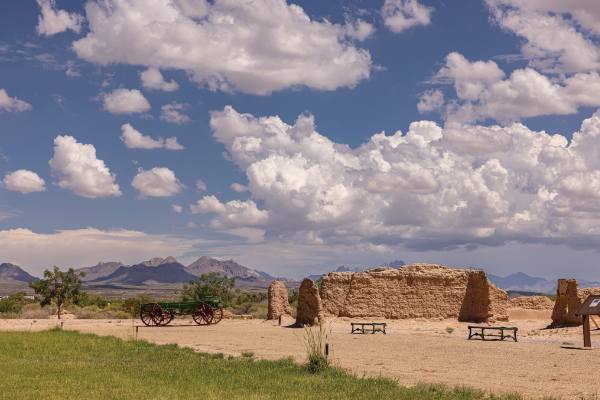
The state’s other historic sites had more compelling and larger calls to action. Lincoln Historic Site and Fort Stanton Historic Site hold numerous buildings that need lifesaving improvements.
The Bosque Redondo Memorial at Fort Sumner Historic Site required a complete reorganization of the story it told about the Long Walk of the Diné and Mescalero Apache. Los Luceros Historic Site had only recently joined the state system and had yet to figure out how to welcome guests.
Meanwhile, archaeological and maintenance work at Jemez and Coronado historic sites demanded action.
“What are the best uses of the very limited resources of the people of New Mexico?” Moore asks. “We try to lift everybody up as best as we can, but there are real challenges: Where are the dollars to support it? The fact that New Mexico does historic preservation at all is significant. But when you have to make a choice between schools, police, fires, highways, it’s all critical. Who gets pushed to the back?”
Thanks to the infrastructure improvements at Fort Selden, he says, the museum can soon change how it represents the site. It’s a story that extends well beyond the fort. The proximity of the Rio Grande has attracted people to the area since at least CE 400. A Mogollon-era pithouse on the property testifies to a centuries-deep history among Indigenous people. Apaches traveled through it for generations before and even after Spanish explorers began using it as a rest stop, called Paraje Robledo, before tackling the harsh Jornada del Muerto portion of El Camino Real.
Western expansion into the region forced violent changes to the Apache people, which is where the fort enters the picture and commands just a quarter-century slice of the larger story. “This wasn’t just Fort Selden,” Dass says. “There’s a lot of depth to it. There are so many angles we need to tell.”
Some of that legwork is done through public program-ming, such as living-history reenactments. This summer, to celebrate the site’s 50th anniversary, a public party that was expected to attract fifty visitors instead hosted hundreds, Moore says. Besides further improvements to Fort Selden, he aims to coordinate programs and exhibits at the site with ones at the Taylor-Mesilla Historic Site and the New Mexico Farm & Ranch Heritage Museum in Las Cruces with a goal of weaving a larger and more complex tapestry of life in the borderland. He’s even talking with New Mexico State Parks officials about looping in nearby Leasburg Dam State Park, thereby deepening visitors’ ties to
the region.
“If money was in an unlimited supply, Fort Selden would be fabulous,” he says. “But right now, the state is putting millions into stabilizing and improving Fort Stanton. I do think there are options at Fort Selden using technology. We’re looking at augmented-reality options, but there’s limited cell phone coverage there. There might be a time in the future when we can do things with digital projections, but many of those would have to be at night, since it’s outdoors.
“All of these things are enormously expensive,” he cautions. “I do think there is some real op-portunity to tell visitors why the site is so important. But we’re fighting against history, climate, and weather.”
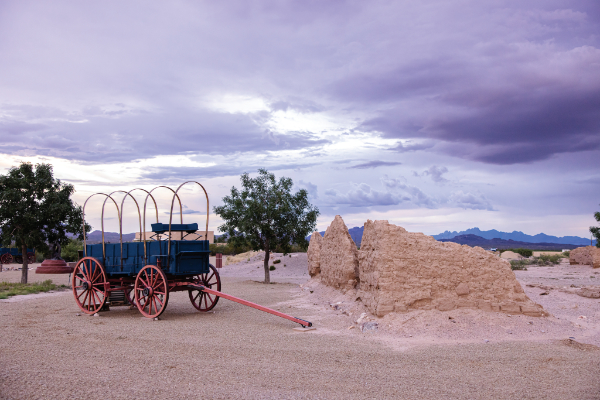
Given those odds, along with the need to tell a more inclusive story of the site, one focused on more than soldiers in adobe buildings, could the time have arrived to reconsider what must be preserved, what can be salvaged, and when adobe should be allowed to melt back into the earth?
State Historic Preservation Officer Jeff Pappas says that’s not his call to make, but he notes the fort, which has been on the National Register of Historic Places since 1970, has qualities that bode well for it. Among them are the continued use of its original materials and the fact that the buildings haven’t been moved to new locations. “Under historic preservation law, you can certainly recreate a building,” he says. “If you’re doing it within the same context, that’s allowed.” As for how far the law can bend in using next-gen materials with longer lifespans, Pappas advises keeping the fort’s options open.
“We really trust the judgment of Pat and Mike Taylor on that,” he says. “The closer you can get to the original material is good, but newer materials can be taken into consideration. The secretary of the Interior Department is really flexible when it comes to reconstruction.”
Moreover, he says, Fort Selden has a narrative that can grow as we learn more about our own history, underscoring its reason for being and for the Historic Sites Division’s plans.
“There are all these engagement opportunities,” Moore says. “The site looks dramatically different than it did a few years ago. We have a new entry, new parking lot, an ADA-compliant path. We get railed on for how little we do to protect it, but every time I go there, I’m giddy as a school kid—‘Hey, there’s a new floor!’ This is an incredibly important site. It’s a slow process, but it’s a beautiful site in ways it wasn’t before.”
—
Kate Nelson is a freelance writer who lives in an adobe home in Placitas and likes to imagine a future resident patting its warm and sturdy walls, as she often does herself.
